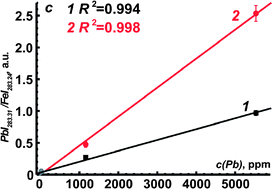To improve analytical figures-of-merit of the single-pulse LIBS for determination of trace elements in soil samples, a new configuration for spatial confinement based on a special designed device described recently in our work (A.M. Popov, F. Colao and R. Fantoni, J. Anal. At. Spectrom., 2009, 24, 602–604) was studied. The confinement tool realized is a small chamber (about 4 mm in diameter) equipped with polished brass walls and high efficiency collecting optics. A specific analytical procedure was developed to clean the chamber from impurities of microparticles deposited on surface of its walls after each experiment. Investigating the influence of focusing conditions on the stability of LIBS emission signal we have found that the relative standard deviation (RSD) of LIBS signal decreased as the distance between the focus position and the sample surface increased. So, the optimal position of the focus was found below the sample surface as a compromise between the need of collecting intense emission signals and of avoiding breakdown from the ejected microparticles. A significant intensity enhancement was observed inside the chamber, its use as an analytical tool was deeply investigated. The intensity enhancement, obtained on several major (Fe, Mg, Si) and trace elements (As, Ba, Cr, Hg, Mn, Ni, P, Pb, Ti, V) in the examined samples was significantly larger than the decrease of signal-to-noise ratio associated with the slightly worst statistics in the reproducibility of single-shot spectra inside the chamber. The 3σ-limits of detection (LOD) of As, Hg, Pb, Mn, V and Ba in soil by using the confined plasma were 30, 25, 90, 140, 1 and 50 ppm, respectively, resulting 2–5 times lower than LODs obtained for a free-expanding plasma under the same experimental conditions.


 Please wait while we load your content...
Please wait while we load your content...